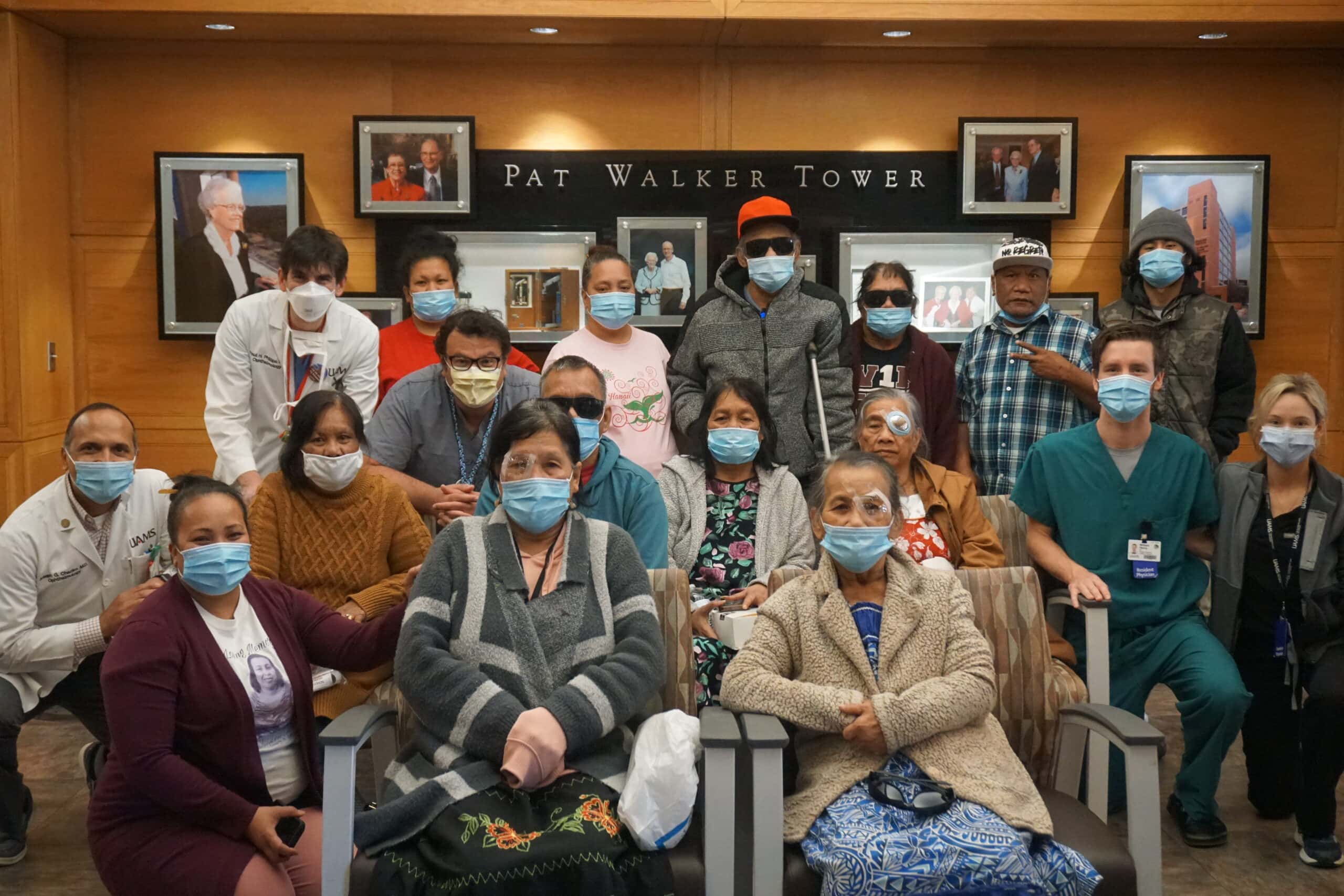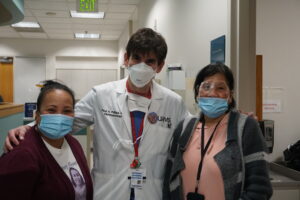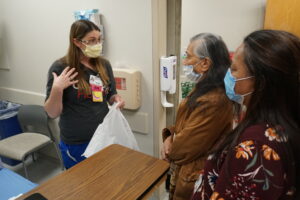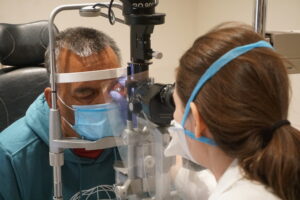View Larger Image

Eye Institute staff pose for a group photo with the Marshallese patients and their families.
Image by Benjamin Waldrum
Marshallese Patients Receive “Gift of Sight” Thanks to Jones Eye Institute
| The morning of Saturday, April 9 was sunny, and Barmej Tibies had to wear special dark sunglasses to shield her healing eyes. But she felt like a movie star.
Tibies and five other Marshallese patients from Northwest Arkansas received cataract surgeries April 8 as part of the UAMS Harvey & Bernice Jones Eye Institute’s second “Gift of Sight” event in as many years. Surgeries, transportation, and food were provided at no cost to the patients, thanks to generous Eye Institute donors who contributed to a fund for this cause. Many of the patients also were covered by Medicaid.
Patients were excited to see clearly again for the first time in years. Tibies has some catching up to do: she has nine children and nearly 40 grandchildren to visit.

Interpreter Terry Takamaru (left), Paul Phillips, M.D. (center) and patient Libos Gold (right) were all smiles after postoperative exams.Benjamin Waldrum
“I usually don’t go anywhere or do anything, I stay at home,” she said through an interpreter. “I can see much better now. I will be able to read my Bible more easily and be able to better manage my health and diabetes.”
Northwest Arkansas is home to the largest Marshallese population in the continental United States after many citizens from the Marshall Islands migrated to the U.S., beginning in the 1950s. Their legal migration occurred after the U.S. detonated more than 65 nuclear test bombs that destroyed some of their islands and ecosystems.
“Thanks to generous donors, we were able to perform cataract surgeries on 21 patients last year at no charge to the patient,” said Paul Phillips, M.D., Eye Institute director and chair of the UAMS Department of Ophthalmology in the College of Medicine. “However, with a population of about 14,000 Marshallese in Northwest Arkansas, we knew there were more patients who needed treatment.”
A cataract causes the lens of an eye to become cloudy, eventually leading to vision issues or blindness. Cataract surgery removes the cloudy lens and usually replaces it with a clear, artificial lens. The surgery typically takes just less than 30 minutes but costs thousands of dollars without insurance, Phillips said.

Stephanie Moran, RN (at left) explains preoperative procedures to patient Loreenn Turinto (center) and interpreter Pearl Atlan (right).Benjamin Waldrum
UAMS provided transportation from Northwest Arkansas to Little Rock for the patients, who arrived April 8 for preoperative exams, followed by cataract surgery. They stayed overnight at provided accommodations before returning Saturday morning, April 9, for postoperative exams.
“In this case, if these patients don’t come here, the surgeries aren’t being done – that’s why they’ve tolerated this for years and years,” Phillips said.
The inability to see or see clearly had significantly affected their quality of life, but no longer. Following the surgeries, patients spoke about how their lives have changed for the better.
Tony Lmooth had trouble standing up because of poor sight in his right eye. “He only saw with his left side, that was it,” said his grandson, Orlando Lmooth. Although some of the Marshallese patients were at UAMS for their second surgery, this was Lmooth’s first.
After surgery, he was surprised to immediately see letters and pictures. “Now that I can see, I can grab things from shelves and know what my medicines are,” Lmooth said.
Loreenn Turinto, 80, can now see clearly out of both eyes following her second surgery in two years. Before, her cataracts were so bad that she couldn’t see words when she would try to read. “I’m very happy,” she said. “Now I can see, I can walk, go to church — things I’ve never done.”

Carina Sanvicente, M.D. (foreground) checks on patient Conny Ishoda’s sight before the surgery.Benjamin Waldrum
Alongside Phillips, the event was organized by Shelli Madison and Terry Takamaru. Pam Collier, Lyndsay Dupree, Kara Stewart and Jeremy Lemmons helped streamline the clinical evaluations. Takamaru and Pearl Atlan served as translators and helped coordinate the patients’ visit to UAMS. Valarie Robinson, Marilee Taylor, Stewart and Shannon Coleman volunteered administrative support. Sheena CarlLee, M.D., and Stacia Dean helped coordinate in Northwest Arkansas. Alvin Stewart, M.D., Joe Jimmerson, Ph.D., RN, and Tammy Jones, Ph.D., RN, tackled logistics in the operating rooms to help make the surgeries successful.
Alli Meyers assisted with patient check-in. Clinical staff members Aubrey Adams, Ashley Banks, Valeri Green and Venus Wright helped complete the preoperative exams. Paul Pugh, Stefanie Daniels, Angi Covert and Alejandra Pelayo assisted with surgery approval.
A team composed of Joseph Chacko, M.D., Ahmed Sallam, M.D., Carina Sanvicente, M.D., Heather Broyles, D.O., and William Henry, M.D., reviewed medical records to identify patients, led the preoperative and postoperative exams, and performed the surgeries.
“We think of cataract surgery like a routine, bread-and-butter case, but there are people who are actually blind from cataracts, which just shouldn’t happen because it’s a treatable cause of blindness,” Broyles said. “I think it’s way better when you’re able to help someone who completely lost their independence from something like a cataract – and in one day, they can get it back.”

Heather Broyles, D.O. (left) with patient Tony Lmooth (right). Lmooth was able to immediately see images and pictures the day after his surgery.Benjamin Waldrum
All six patients will be back at the Eye Institute in a month for follow-up exams. Phillips said he hopes to bring many more patients in for these surgeries.
“The goal of this round was to establish a process that we can continue with additional patients every couple of months, and there will be more group cataract surgeries like these in the future to take care of additional patients,” Phillips said.
As the patients and their friends and family members gathered in the Eye Institute lobby to say goodbye, they insisted on giving something back to the doctors who saved their sight. So they stood together and sang, harmonizing together and clapping to the rhythm.
“There’s not much else you can do in medicine that has such a good reward immediately after like this does,” Henry said. “It’s unique to ophthalmology, and it’s one of the main reasons I chose this field.”